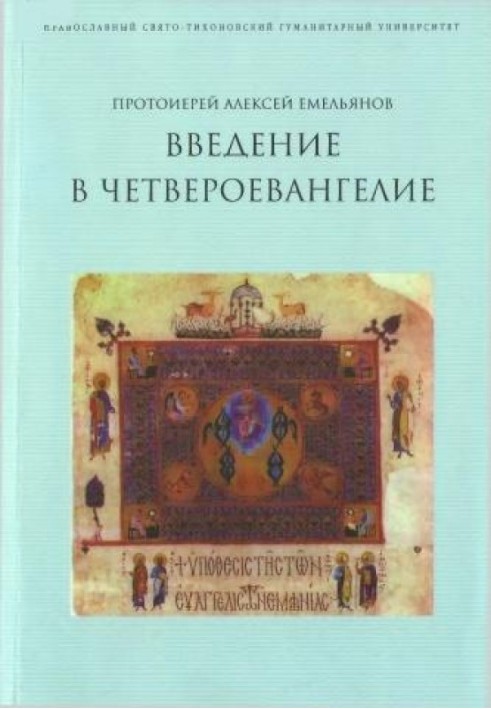Introduction to the Four Gospels
 Instant download
Instant download
after payment (24/7)
 Wide range of formats
Wide range of formats
(for all gadgets)
 Full book
Full book
(including for Apple and Android)
“Introduction to the Four Gospels” is a textbook introducing the problems of modern biblical studies. In addition to the standard sections for books with this title about the historical and cultural context in which the New Testament texts appeared, the circumstances of their origin and transmission, it also pays attention to methodological issues of biblical scholarship. The patristic and modern approaches to the interpretation of the biblical text are reviewed and compared for informational purposes. For teachers and students studying in the specialties “Theology” and “Religious Studies” and other specialties, as well as for a wide range of readers interested in the Bible. Source : Table of contents: 1. Subject and tasks biblical science2. Structure of Biblical Science2.1. Introduction (isagogy)2.2. Composition of the introduction to the New Testament2.3. Biblical hermeneutics2.3.1. The need for hermeneutics2.3.2. The relationship between the terms “hermeneutics” and “exegesis”2.3.3. The concept of inspiration is a central hermeneutical problem2.3.4. Controversial problems of hermeneutics2.4. History of the canon of biblical books2.5. Biblical textual criticism2.6. Biblical philology and lexicography2.7. History of biblical exegesis2.8. Biblical archeology and auxiliary disciplines2.9. Exegesis (exegesis)3. Methods of Biblical Science3.1. Jewish tradition of interpretation and its influence on early Christian exegesis3.2. Allegorical method of interpretation3.3. Brief outline of Christian exegesis3.3.1. Christian exegesis before Origen3.3.2. Exegesis of Clement Alexandrian and Origen3.3.3. Antiochene and Alexandrian exegesis3.3.4. Typology as an alternative to allegory3.3.5. Principles of hermeneutics of St. Augustine 3.3.6. The concept of four levels of meaning of Holy Scripture3.3.7. Medieval exegesis3.3.8. Conclusions. Characteristic features of patristic exegesis3.4. Historical-critical research method4. Essay on the history of the development of biblical scholarship in the West in the modern period4.1. Textual criticism (for more details, see paragraph 9)4.3. Criticism of forms (form analysis) 4.4. Criticism of editors4.5. Question about the “historical Jesus”4.6. Finding the “authentic words of Jesus”4.7. Conclusions4.8. Conclusion5. Political and social context of the New Soviet era5.1. Review of political history5.1.1 Herod the Great and his reign. Herodian Dynasty.5.2. Review of the social environment5.2.1. Languages of Palestine5.2.2. Communication routes6. Religious and cultural context of the New Testament era6.1. Overview of the religious and cultural cross-section of Judaism6.1.1. Intertestamental Jewish Literature6.1.2. Jewish parties and sects in the era of the New Testament6.1.3. Jerusalem Temple and its ritual6.1.4. Jewish holidays6.1.5. Synagogue6.2. Overview of the Pagan Religious and Cultural Environment7. Terminology7.1. The term “New Testament”7.2. The term “Gospel”7.2.1. Old Testament origins of the term “Gospel”7.2.2. The word “Gospel” in modern language7.2.3. Use of the term “Gospel” in the New Testament7.2.4. The use of the term by the apostolic men and the early Church Fathers7.2.5. One Gospel or several7.3. The term "canon"7.4. The term "apocrypha"7.4.1. Classifications of apocryphal gospels7.5. “Controversial writings”7.6. Agrafa8.1. Criteria for canonicity8.2. The main stages of the formation of the New Testament canon8.2.1. Early period (1st century)8.2.2. The period of the apostolic men (end of the 1st - beginning of the 2nd century) 8.2.3. From the era of the fight against Gnosticism to Eusebius of Caesarea (second half of the 2nd - first half of the 4th century) 8.2.4. Final period (second half of the 4th-5th centuries) 8.2.5. Conclusion8.2.6. Conclusions9. Textuality of the New Testament9.1. Brief outline of New Testament paleography9.3. Some conclusions from textual studies9.4. Editions of the Greek text9.5. Ancient translations of the New Testament9.6. Slavic translation of the New Testament9.7. Russian translation of the New Testament10. Church tradition about the origin of the Gospels10.1. Gospel of Matthew 10.1.1. Information about the Evangelist Matthew 10.1.2. Church tradition and the opinion of biblical criticism about the creation of the Gospel10.2. Gospel of Mark10.2.1. Information about the Apostle Mark10.1.2. Church tradition and the opinion of biblical criticism about the creation of the Gospel10.3. Gospel of Luke 10.3.1. Information about the Apostle Luke10.3.2. Church tradition and the opinion of biblical criticism about the creation of the Gospel10.4. Gospel of John10.4.1. Information about the Apostle John10.4.2. Church tradition and the opinion of biblical criticism about the creation of the Gospel11. Synoptic problem11.1. Similarities between the Synoptic Gospels11.2. Differences between the Synoptic Gospels11.3. Definition of the concept “synoptic problem”11.4. Church tradition on the relationship between the Synoptic Gospels11.5.1. Advantages of Griesbach's hypothesis11.5.2. Disadvantages of Griesbach's hypothesis11.5.3. The merits of the two-source hypothesis11.5.4. Disadvantages of the two-source hypothesisAppendices1. Messianic prophecies of the Old Testament mentioned in the Gospel2. People and events related to the New Testament3. Table of canons of the first four centuries5. Description of the Essenes sect by Josephus6. Eusebius Pamphilus about the Apostle John the Theologian7. Testimonies of non-Christian writers about Jesus ChristLiteratureSourcesResearch
FL/811295/R
Data sheet
- Name of the Author
- Алексей Емельянов Николаевич
- Language
- Russian













